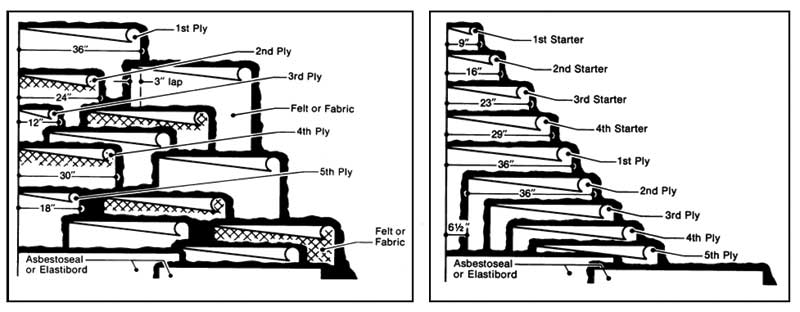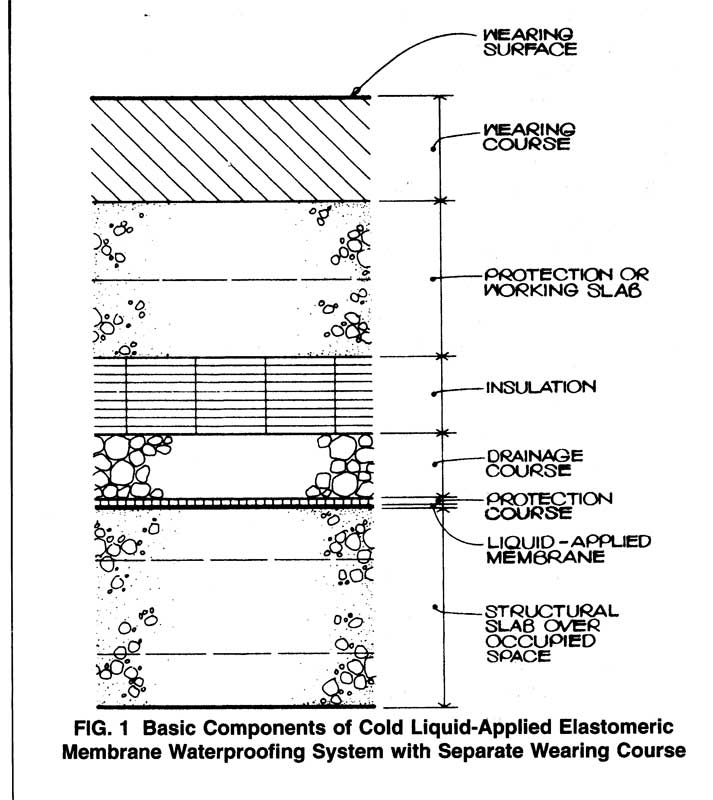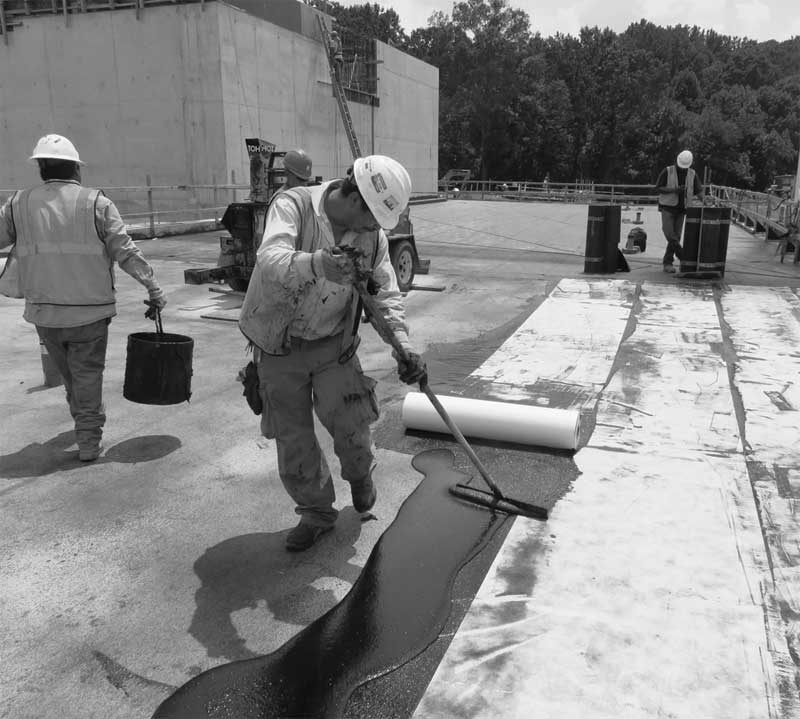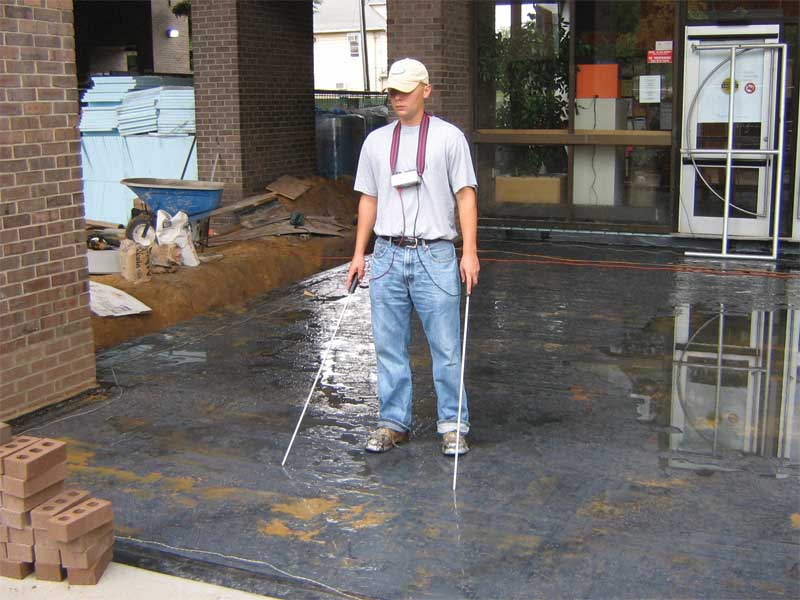The evolution of plaza waterproofing
by Katie Daniel | February 7, 2017 10:35 am
 [1]
[1]by Justin Henshell, FAIA, FASTM
Non-stop increases in urban land costs have led to more efficient use of space by building owners. This includes not only building upward, but also downward. Waterproofed plazas over occupied underground facilities and roof terraces (sometimes called waterproofed decks) became popular ways of maximizing both horizontal and vertical space. Underground spaces were once limited to storage areas, access tunnels, and parking garages. However, with the advent of air-conditioning, they became suitable for computer server rooms, offices, and public-assembly rooms. City planners encouraged architects and building owners to provide plazas as a means of expanding open space in crowded cities.
This article outlines the evolution of waterproofing plazas and terraces designed for pedestrian and light vehicle use over occupied spaces. It should prove useful to designers and waterproofing manufacturers who seek to avoid repeating the failures of the past. (This author is indebted to Dean Rutila, senior principal at Simpson Gumpertz & Heger [SGH] Engineers for reviewing the manuscript and contributing his insights gained in over 15 years of designing and investigating plaza deck waterproofing. As plaza waterproofing is in constant flux, this author would also appreciate any corrections or updating readers may have.)
The built-up bituminous membrane era
Prior to World War II, waterproofing over below-grade occupied spaces consisted of a built-up membrane of alternate layers of hot coal tar pitch reinforced with tarred rag and jute felts. The felts were assembled in a one-on-one or ply-on-ply system, usually applied as a two-or three-ply (sometimes shingled), then covered with two additional plies (Figure 1). Membranes were often surfaced with a pour coat of hot coal tar pitch prior to the placement of a concrete wearing course or the installation of quarry tile on a cement setting bed.
 [2]
[2]Image from Philip Carey Co. Waterproofing Catalogue, 1971
The wearing surface, which was exposed to the elements, moved in response to ambient temperature changes. As it was bonded directly to the membrane, it often produced inplaner stresses at the interface between the two. In winter, these stresses would cause splitting of some of the plies closest to the surface. However, they would reseal themselves because of the cold-flow properties of the coal tar pitch. The self-healing qualities were enhanced by heat from the space below, which kept the membrane warm. Heating oil and coal were inexpensive, so slabs were not insulated.
Coal tar pitch has low viscosity, and softens easily. Its ability to flow under all temperatures and heal itself is one of its most beneficial physical/chemical properties. This self-healing quality and superior water resistance made it the ideal membrane for use on plazas over occupied spaces in that era. Pitch and pine tar were also known for their water-resistant properties—in their many forms, they had been used for centuries to caulk the wood hulls of ships.
Coal tar pitch was produced as a residue (called ‘destructive distillation’) when coal was fired in closed vessels in the absence of air in order to make coke. Coke was an important constituent in the manufacture of blast-furnace steel. Roofing and waterproofing manufacturers refined this residue to produce waterproofing and roofing bitumens, as well as creosote.
Coal tar pitch was also used to waterproof basement walls subject to hydrostatic pressure. Foundations were constructed using bricks dipped in hot coal tar pitch to form a waterproof masonry wythe, against which the concrete foundation wall was cast.
Asphalt became a step down from coal tar pitch
Shortly after World War II, a United Mine Workers of America (UMWA) strike devastated the coal industry. The work stoppages effectively cut off the supply of coke to steel mills—and with it, the by-product of coal tar pitch. Roofing and waterproofing manufacturers and contractors were left without their only reliable source of pitch, which had served them so well since the 17th century. They were forced to switch to roofing asphalts, which were a by-product of the oil refineries’ distillation process.
Lloyd A. Fry, a roofing manufacturer in the Midwest, produced various grades of roofing asphalts, including those that were unblown—an oxidizing process to increase resistance to flow on steep roofs. In 1937, ASTM published the first consensus standard for waterproofing asphalt. It specified three types with varying degrees of softening points—Types I, II, and III. Type I, the least viscous, was defined as a soft, adhesive, “self-healing” asphalt suitable for below-grade waterproofing in moderate temperature conditions.
Waterproofing contractors used self-healing asphalt with varying degrees of success. The membranes employed asphalt-saturated organic felts, generally made from waste paper, for reinforcement. They lacked the strength of rag felts used with pitch due to the shortage of suitable rags and jute following the war.
Asphalt and coal tar pitch are chemically different; the former is an aliphatic and the latter is an aromatic. One of the differences includes the ability to self-heal—coal tar pitch is notably better in this regard and is capable of self-healing at lower temperatures. When designers changed from coal tar pitch to asphalt waterproofing, they did not consider the importance of self-healing until they were faced with a rash of failures. Wearing courses were applied directly to three- and four-ply reinforced asphalt waterproofing membranes, as was traditional for coal tar pitch membranes. Low ambient temperatures reduced the asphalt’s ability to self-heal. Leaking was common when the wearing slab that was bonded to the asphalt-based membrane moved differentially and ruptured it.
A concomitant number of factors combined to acerbate the waterproofing splitting problem that resulted in leaking. Basements that had been used solely for boiler rooms and storage spaces now housed moisture-sensitive auditoriums and server-computer rooms. These spaces were climate-controlled, which required insulation, sometimes installed on the soffit of the slab—this effectively reduced the beneficial warming from heat loss that permitted bitumen to self-heal. At the same time, advances in engineering resulted in thinner structural slabs, permitting greater deflections and creep that overstressed asphalt membranes’ tensile strength. (For more, see S.S. Ruggiero and Rutila’s work in ASTM STP 1084, Principles of Design and Installation of Building Deck Waterproofing, published in 1990.) Further compounding the situation, manufacturers reduced the amount of asphalt used to saturate the felts.
 [3]
[3]Image courtesy ASTM International
Design progress begins in the mid-1960s
Asphalt membrane splitting problems were greatest in Canada, where low ambient temperatures were the norm. The Division of Building Research of the National Research Council of Canada (NRC) had assembled a remarkable group of building pathologists who authored the Canadian Building Digests. One of these was G. K. Garden. In a March 1966 article about roof terraces, he advocated use of a drainage medium between the membrane and the wearing course. This drainage layer effectively divorced the membrane from the stresses associated with differential movement between membrane and wearing slab. He also noted the importance of sloping the membrane to drain.
Garden’s concepts were subsequently incorporated in Charles J. Parise’s 1971 book, Architectural Considerations in Plaza Membrane Waterproofing Systems. (Parise’s work appeared in the May 1971 edition of ASTM International’s Materials Research & Standards [vol. 11, no. 5].) The principles Parise espoused were eventually incorporated into ASTM C898 for liquid-applied waterproofing in 1978 (now titled Standard Guide for Use of High Solids Content, Cold Liquid-applied Elastomeric Waterproofing Membrane With Separate Wearing Course), under the jurisdiction of subcommittee C24.80, which he chaired. This was followed by C981, Standard Guide for Design of Built-up Bituminous Membrane Waterproofing Systems for Building Decks in 1983.
The plaza waterproofing assembly consisting of a structural slab sloped to drain, membrane drainage course, insulation, and wearing course was widely implemented in the industry (Figure 2). It markedly reduced incidents of leaking from differential wearing slab movement. Moreover, introduction of more robust flashing materials and movement joints at membrane terminations reduced failures that had been common with stripped-in metal base flashings.
Alternative membranes come of age
Some manufacturers of atactic polypropylene (APP) and styrene-butadiene-styrene (SBS) modified bitumen roofing felts marketed their multiple-ply systems for use as waterproofing systems on plazas. Those proved to be unsuitable because the cut edges of the sheets allowed water to wick into the reinforcing, causing swelling and subsequent disbonding. Some manufacturers now use a non-woven polyester reinforcing that avoids this problem.
Built-up, hot-applied asphalt and glass fiber felts disappeared from the market because of labor intensity and high water absorption under ponding conditions. Built-up coal tar pitch membranes with glass fiber felts failed when the glass fiber reinforcing migrated to the bottom of the membrane, leaving little or no interplay pitch between the felts. Restrictions regarding volatile organic compounds (VOCs) eventually caused their complete demise. That paved the way for an influx of single-ply and liquid-applied membranes.
The success of reliable single-ply roofing systems encouraged their use as plaza waterproofing membranes, which proved to be far superior to the built-up asphalt and felt membranes they supplanted. In addition to the use of single-ply membranes, liquid-applied waterproofing membranes were introduced in the 1960s. These included cold-applied, coal-tar-modified polysulfide single-component membranes, and hot-applied rubberized asphalt. The former proved
to be too sensitive to temperature extremes and was subsequently abandoned in favor of one- and two-component urethane-modified bitumens. Although the polyurethane-modified bitumens were not temperature-sensitive, they were extremely moisture-sensitive.
 [4]
[4]Photos courtesy Henshell and Buccellato Consulting Architects
Liquid-applied membranes
Subsequently, a host of liquid-applied elastomers, including polyesters, polyethers, one- and two-component synthetic rubber and asphalt emulsions, and polymethyl methacrylate (PMMA and MMA) were marketed for plaza waterproofing. These elastomers cured by exposure to air (one-component membranes) or by chemical reaction (two-component membranes), as shown in Figure 3.
Hot-applied rubberized asphalt was another liquid-applied plaza waterproofing membrane. It was introduced from Canada by a number of rubber companies in the 1960s and 1970s. These products were polymer-modified asphalt mixed with rubber crumbs and clay, applied hot over a primed deck. They formed a membrane as soon as they cooled. They also adhered better to slightly damp concrete substrates. (For further information on hot-applied rubberized asphalt waterproofing membranes, see Tim Barrett’s articles in the February 2000 and November 2013 issues of RCI’s Interface magazine. In addition to Parise and Garden, no discussion of plaza waterproofing would be complete without mentioning two pioneers instrumental in influencing its development: Dorothy Lawrence, FASTM, and David Spalding. Lawrence compounded a neoprene-modified asphalt sheet with the addition of carbon black applied to a woven-glass carrier in 1949. The membrane system consisted of these sheets interlayed with a compatible adhesive applied cold in two plys. It required no primer and adhered to moist concrete. This membrane was installed on Cobo Hall in Detroit in 1959—it still performs satisfactorily. Spalding marketed a hot-applied rubberized asphalt imported from Canada in 1977. The product, composed of polymer-modified asphalt with rubber crumbs and clay, was heated in a double-jacketed kettle and squeegeed over a primed concrete deck. It ‘cured’ as soon as it cooled, in contrast to polyurethane and other cold-applied waterproofing membranes. Spalding’s singular contribution to this product was to reinforce it with a polyester fabric in the 1980s. This required two coats at a total thickness of 5.5 mm [215 mils], which provided redundancy and solved the problem of pinholing and cratering that had plagued other producers. It also solved the problem of heating resin-type formulations to the degree it impaired adhesion.) Single plies
Producers of single-ply sheet roofing also marketed their sheets for use on plazas in the mid-1960s. A 1968 article in Concrete Construction lists membranes made of “natural and synthetic rubber, vinyl, neoprene,” as well as “asphalt reinforced with glass fibers bonded to high-strength backing.”
Synthetic rubber sheets, including butyl and ethylene propylene diene monomer (EPDM), and polyvinyl chloride (PVC), were manufactured by several companies. These products were used on roofs as well as under paved plazas and vegetative roofs. Subsequently, market forces and consolidations led to fewer single-
ply manufacturers.
Many products have been improved since their introduction. PVC membranes are installed loose-laid over bonded strips that provide compartmentalization to simplify leak detection. Moisture-resistance of EPDM adhesives has been improved, and redundancy is provided by cover strips over the seams.
Consisting of 1.4 mm (56 mils) of asphalt modified with reclaimed rubber and resin modifiers laminated to 0.1 mm (4 mils) of high-density polyethylene (HDPE), 1.5-mm (60-mil) thick self-adhering rubberized asphalt sheets were introduced into the United States from Europe in the 1970s. As they had factory-controlled thicknesses, were applied cold, and required only a single ply to perform satisfactorily, they rapidly dominated the market.
When the initial manufacturer’s patents expired, similar products with different modifiers and asphalts were marketed by more than a dozen firms. Some manufactured products, while others rebranded existing products. Thinner versions were marketed for through-wall flashing, shingle underlayments, and air/vapor barriers. Some producers of rubber-modified asphalt plies persisted and developed successful hot- and cold-applied built-up systems still used in new construction.
Plaza waterproofing today
Today, at least 60 waterproofing products are marketed in the United States for use under plazas. These include:
- more than 30 one- and two-component cold liquid-applied systems;
- nine hot-applied rubberized asphalt membranes;
- 15 manufactured sheet membranes; and
- at least five built-up membranes.
The majority of these do not list resistance to hydrostatic pressure as a physical property or claim they are suitable for below-grade use. Only a few manufacturers say they can be used in split-slab configurations in which the wearing course is cast directly over the membrane. However, most adhere to the principles espoused by Garden and Parise, requiring a drainage medium and/or insulation to divorce the wearing surface from the membrane.
More versatile polymer-based liquid-applied membranes have been developed. Many were first used in Europe. Increasingly stringent VOC requirements have forced many manufacturers to reformulate existing products or design new ones that conform. Water-based primers have supplanted their solvent-based counterparts. Epoxy primers are increasingly used on decks that are not as dry as moisture-sensitive membranes require. Membranes with shorter curing times have been developed in response to the demands of tighter construction schedules.
Some currently marketed hybrid sheet membranes and systems are factory-laminated, and others are applied as separate layers. In particular, polymer-modified sodium bentonite is laminated to ketone ethylene ester (KEE) membranes for loose-laid applications. Products that could not satisfy Leadership in Energy and Environmental Design (LEED) program proscriptions of environmentally hazardous materials have been withdrawn from the market or reformulated. Multiple-ply membranes previously applied with hot adhesives are now applied with cold adhesives. Torch-fused sheets and seams are rapidly giving way to robotic hot-air-fused seams, eliminating the need to maintain a fire watch after the last torch is extinguished.
Self-adhering membranes are beginning to dominate the field, although hot-applied rubberized asphalt is a strong competitor in some markets. Two-component sprayed or squeegeed liquid-applied polymers, such as polyester and PMMA, have recently become very popular.
 [5]
[5]New developments and industry challenges
This look at the past of waterproofing leads us to the present and immediate future of the industry and its product development. Bentonite manufacturers are modifying their clay with polymers and producing many hybrid systems. PVC manufacturers are modifying their sheets with greater amounts and more sophisticated forms of KEE plasticizers. Manufacturers are continuing to replace hot-applied adhesives with cold-applied adhesives. New fluid-applied products continue to appear as manufacturers try to improve performance. The industry is adopting electronic testing to verify membrane integrity in lieu of flood testing (Figure 4). Plastic drainage composites have completely supplanted aggregate drainage courses.
Manufacturers are struggling to develop primers and systems permitting application of their products on concrete decks containing injurious amounts of moisture. Lack of adequate adhesion has become a greater concern than tensile failures. In this author’s opinion, the greatest single problem facing the industry is substrate moisture. Design/construction professionals still need a reliable test for moisture in concrete slabs, along with a universally acceptable definition of what ‘dry’ means. (The definition of cured concrete is when it reaches its design compressive strength in seven days. Concrete is ‘dry’ when the percent of vapor transmission rate, in lb/1000 sf/24 hours is less than 75 to 80 percent, as per the 15th edition of the Portland Cement Association’s (PCA’s) Design and Control of Concrete Mixtures (Steven H. Kosmatka and Michelle Wilson), which is available at www2.cement.org/pdf_files/eb001.15.pdf[6]. This definition is generally agreed on by the floorcovering industry, but not accepted by the roofing/waterproofing industry.) Simple, economical methods for reducing elevated moisture content are also necessary.
This problem is not limited to adhered waterproofing systems. Manufacturers of loose-laid sheets find difficulty with adhering compartmenting strips to concrete substrates. Adhesive seams can disbond from water under the membrane. Bentonite coatings can become pre-hydrated.
Parise, Garden, and their colleagues overcame the splitting problems. Now, it becomes our hope contemporary problems can be as easily solved by the next generation of plaza waterproofing systems.
| THE ROLE OF ASTM INTERNATIONAL |
| ASTM Subcommittee D08.22 on Waterproofing and Dampproofing Systems was formed in 1993 by Charles Pratt of Koppers Co. and Dorothy Lawrence of Laurenco Waterproofing. Currently it has more than 20 standards under its jurisdiction. In 2000, James Strong of WJE, who chaired subcommittee C24.80, was instrumental in transferring the standards for liquid-applied waterproofing under its jurisdiction to D08.22. In addition to standards for waterproofing materials and applications, this committee has developed standards for drainage media and concrete preparation, and test methods for membranes’ physical properties and integrity. Currently it is developing a new standard for hot-applied rubberized asphalt to replace the Canadian standard that was withdrawn several years ago. |
Justin Henshell, CSI, FAIA, FASTM, is a principal in the firm of Henshell & Buccellato Consulting Architects, specializing in moisture-related issues in the building envelope, since 1974. His focus includes roofing, masonry walls, waterproofing, and condensation. Henshell has authored more than 40 technical articles and papers, presenting them in the United States, Canada, and Europe. He wrote The Manual of Below-Grade Waterproofing (Routledge, 2016). Henshell can be contacted via e-mail at justin.henshell@verizon.net[7].
- [Image]: https://www.constructionspecifier.com/wp-content/uploads/2017/02/Mar19-2012-A.jpg
- [Image]: https://www.constructionspecifier.com/wp-content/uploads/2017/02/FIGURE-1-water.jpg
- [Image]: https://www.constructionspecifier.com/wp-content/uploads/2017/02/FIGURE-2-water.jpg
- [Image]: https://www.constructionspecifier.com/wp-content/uploads/2017/02/FIGURE-3-water.jpg
- [Image]: https://www.constructionspecifier.com/wp-content/uploads/2017/02/FIGURE-6-water.jpg
- www2.cement.org/pdf_files/eb001.15.pdf: http://www2.cement.org/pdf_files/eb001.15.pdf
- justin.henshell@verizon.net: mailto:justin.henshell@verizon.net
Source URL: https://www.constructionspecifier.com/the-evolution-of-plaza-waterproofing/